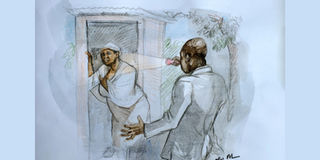Prime
The murder trial of Nyangasi

What you need to know:
It was therefore the prosecution’s case that Appollo Nyangasi strangled his wife, Christine, to death
Appollo Dalton Nyangasi, the former chairperson of the Medical Workers Union, was indicted for murder on July 24, 2010.
Particulars
The particulars of the offence were that at Kireka B Zone, Kira Town Council in Wakiso District, he, with malice aforethought, unlawfully killed his wife Christine Nyangasi Dambio.
He denied the charges when he was arraigned before court. The prosecution produced 13 witnesses to prove its case.
Marriage
Nyangasi and Christine got married in 1993 and the two settled in Kireka B Zone and were blessed with two children. However, their marriage went on the rocks and was characterised by frequent quarrels, accusations and fights. Although there were many attempts by family members to resolve their differences, Christine eventually moved out of the matrimonial home and started to live in another house located in the same courtyard.
Woes
She was, however, worried about her life and told her siblings and friends and whoever cared to listen that Nyangasi had many a time threatened to kill her.
Christine told her brothers that one of the causes of their marital woes was that Nyangasi was planning to sell their property to which she was opposed. Nyangasi also wanted Christine out of his life in order to bring in his former girl-friend with whom he had fathered a child.
Witness account
On the early morning of July 24, 2010, Nyangasi walked to Christine’s house and banged the door and told the occupants to open it. After a short while they opened the door but Christine walked out and went to the latrine which was outside the house. Nyangasi followed her to the latrine and before long Christine was heard screaming loudly.
The scream attracted Christine’s relatives who rushed to see what was happening and one of them was later to say that she saw Nyangasi strangling Christine and as soon as he saw her he rushed away, leaving Christine struggling for breath. Her relatives got a vehicle and rushed her for medical help but she died on the way to hospital.
Nyangasi denies charges
Nyangasi denied the charges and made an unsworn statement to the effect that he was in the drug shop on the outer side of the courtyard trying to catch an early customer and was, therefore, not at the scene of crime. The burden was, therefore, on the prosecution to prove beyond reasonable doubt that Nyangasi planned to kill his wife and that he did so deliberately. This in reality meant that in order for the prosecution to succeed in securing a conviction it had to present very strong evidence that reflected a high degree of probability that Nyangasi committed the offence he was accused of. The courts have described such evidence as so strong as to leave only a remote possibility in his favour which can be dismissed with the remark that of course it is possible but not in the least probable.
More witness account
Two nieces of the late Christine who were staying with her at the time of her death told court that when they heard her scream while in the toilet that fateful morning, they rushed to the toilet and saw her lying on the floor with eyes agape. One of the ladies, together with the guard, hurried her to hospital where unfortunately the doctor pronounced her dead on arrival. Christine’s body was taken to the then Kampala City Council Mortuary, Mulago where a post-mortem examination was carried out.
During the post-mortem examination the body of Christine was formally identified by her brother. She was buried in Bugosa Village, Busibira Parish in Butaleja Sub-county of Butaleja District.
Nyangasi did not dispute the fact that his wife was dead; he expressed regret that he was unable to attend the burial of his wife and that his wife had been buried at her father’s home rather than his home.
To court the fact of the death of a person is proved where the body of the victim has been found and the body properly identified and the fact of death is not in dispute. And for this reason the identifying person should be someone who knows the deceased well and therefore capable of identifying the deceased positively, that is, without doubt. Prosecution therefore proved to court the fact of the death of Christine beyond reasonable doubt.
Proving murder
A vital ingredient that the prosecution must prove in a murder trial is that the death of the victim was unlawful. In law, every death of a person caused by another person is presumed unlawful, unless it is accidental or excusable. An accident is an event occurring by chance and not planned and a homicide is therefore accidental if it occurs by chance and was not planned.
On the other hand, a homicide is excusable where, among other things, a person commits it in defence of person or property or if it is in the execution of a lawful sentence that a competent court of law has imposed. Prosecution submitted to the trial court that the death of Christine Nyangasi did not fall under the circumstances envisaged above and the evidence showed that Christine died a sudden death when her husband attacked her.
It was therefore the prosecution’s case that Appollo Nyangasi strangled his wife, Christine, to death. If Nyangasi’s defence team had countered this evidence of the cause and mechanism of Christine’s death, Nyangasi would probably not have received the life sentence that he did. Often fatal mistakes are made at the initial trial that prove difficult to cure in subsequent appeals.
To be continued




